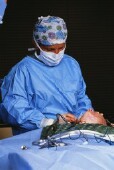- Skip Storing This Everyday Product in the Fridge Door
- Green Tea + B3 Pairing May Boost Brain Health
- Navigating Your Midlife Crisis: Embracing New Possibilities
- City Raccoons Showing Signs of Domestication
- Mapping the Exposome: Science Broadens Focus to Environmental Disease Triggers
- One Week Less on Social Media Linked to Better Mental Health
- Your Brain Changes in Stages as You Age, Study Finds
- Some Suicide Victims Show No Typical Warning Signs, Study Finds
- ByHeart Formula Faces Lawsuits After Babies Sickened With Botulism
- Switch to Vegan Diet Could Cut Your Greenhouse Gas Emissions in Half
Placing Donor Windpipe First in Patient’s Arm Helps With Transplant


Doctors in Belgium say they’ve successfully transplanted windpipes in six patients by first placing donor tissue in the patients’ arms.
“This discovery expands the surgical possibilities for people struggling with difficult-to-repair airway defects,” said Dr. Pierre Delaere, of the department of otolaryngology–head and neck surgery at University Hospital Leuven.
The windpipe, or trachea, is part of the respiratory tract. It allows air to pass from the nose or mouth to the lungs. Damage from accidents and cancer surgery are the most common reasons patients need a windpipe transplant, Delaere said.
Previously, the only option for repairing damage to a long stretch of windpipe was a more extensive organ transplant. This smaller type of transplant was impossible because blood supply to the windpipe, or trachea, couldn’t be restored.
The doctors solved this problem by placing donated windpipe tissue into the patient’s forearm to enable it to grow blood vessels, Delaere said.
When the tissue is placed in the arm, the patient starts taking drugs to prevent its rejection. After three months, surgeons remove the graft from the forearm and transplant it into the patient’s windpipe, where it connects to the blood supply in the neck. Nine months later, the anti-rejection drugs are discontinued, the researchers say.
Delaere’s team describes the breakthrough technique in a report published in the April 17 issue of the New England Journal of Medicine.
“The windpipe transplantation technique was adapted to allow tapering of immunosuppressive therapy and, ultimately, its discontinuation one year after transplantation,” he said.
This becomes possible because the cartilage tissue supporting the airway is not rejected by the immune system, Delaere said.
An advantage to the technique is that stopping the anti-rejection drugs helps avoid nasty side effects associated with their long-term use, the researchers explained. These can include osteoporosis, muscle weakness and increased blood sugar.
In this new report, Delaere’s team reveals the wound-healing mechanisms responsible for survival of the transplant after the immunosuppressive drugs are discontinued.
“The procedure may seem rather complicated. However, in this way the windpipe can be transplanted in a safe and controlled fashion. With some technical improvements, it may become standard therapy for selected cases,” he said.
Other experts expressed mixed opinions, however.
Dr. Sandeep Dave, an ear, nose and throat specialist at Miami Children’s Hospital in Florida, welcomed the findings.
“Although this is a small series of patients and further studies are needed to determine the long-term efficacy of such a transplant, this is nonetheless an exciting development and evolving option for the treatment of certain long-segment windpipe defects,” Dave said.
But Dr. Paolo Macchiarini, a professor of regenerative surgery at the Karolinska Institute in Stockholm, Sweden, and a pioneer in windpipe transplants, isn’t convinced that this method is the best approach.
In most cases, he said, these windpipe problems can be treated with artificial tubes to keep the airway open.
How Delaere’s patients will fare without immunosuppressive drugs over time is still unknown, Macchiarini said, noting this method raises ethical questions about the long-term survivability of the grafts.
“If you really want to save the patient, then do a normal organ transplantation,” Macchiarini said. “We recently did a transplantation of the voice box and the windpipe.”
More information
For more information on organ transplants, visit the U.S. National Library of Medicine.
Source: HealthDay
Copyright © 2025 HealthDay. All rights reserved.










